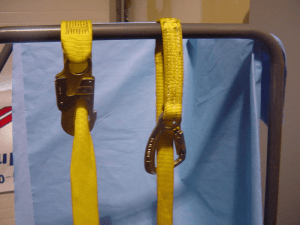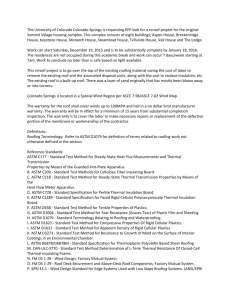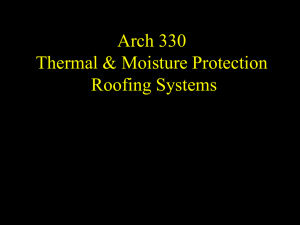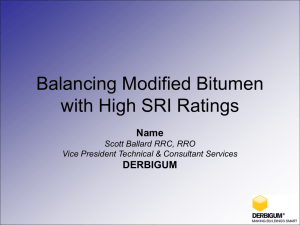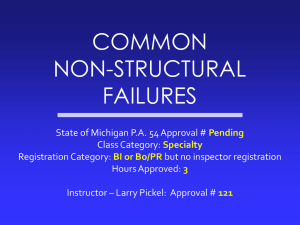PPT - GenFlex Roofing Systems
advertisement
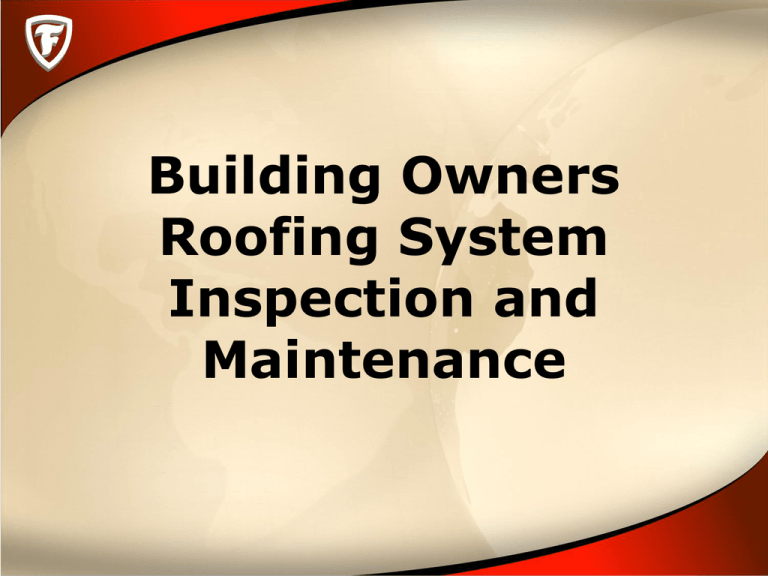
Building Owners Roofing System Inspection and Maintenance Why Inspect and Maintain the Roofing System? • Periodic inspection and maintenance is needed in order for the roof to perform as designed. • Inspection and maintenance is typically required by roofing manufacturers to keep roofing warranties in full force and effect. Proactive vs Reactive Maintenance • Reactive Maintenance: is a response to a existing problem: – Leaks – Repairs after damage due to weather events – Changes in the rooftop (relocated RTUs, new adjacent construction, etc.) Proactive vs Reactive Maintenance • Proactive Maintenance: stopping potential problems before they impact the roofing system - can create significant savings and extend the service life of the roofing system: The above cost analysis was prepared by a development firm owning in excess of 550 million square feet of commercial space. When Should the Roof Be Inspected? • Make a roof inspection plan part of the overall maintenance of the facility – Schedule regular inspections by on-site facility management team – Schedule twice-annual inspections by Roofing Professionals – Inspect following weather events (wind, hail, etc.) – Inspect when leaks or damage occurs Who Should Perform the Inspection? • The local facility staff can perform casual inspections: – Observe and record the status of the roofing system. – Use data gathered to direct a Roofing Professional to problem areas • A Roofing Professional should perform a thorough inspection: – At least twice a year. – Whenever repairs is required. Who Should Perform Maintenance? • Local facility management staff: – Clean single-ply membranes – Remove debris, especially from drains/scuppers/gutters – Locate areas of damage/leaks and safely mark them • Roofing Professionals: – Repair leaks and perform reactive maintenance – Perform proactive maintenance – Provide estimates for future roofing maintenance needs – Use manufacturer-licensed roofing contractors to protect your warranty Inspection Checklists Where to Look - What to Look For Remedial Actions • • • • • • • Rooftop Traffic Areas Contaminants Drainage Components Wind Storm Damage Moisture Infiltration Roof Membrane Seams Base Attachments Rooftop Traffic Areas • Where to Look: – Roof Hatch area or roof access points – Walkways and “natural” paths – Mechanical Equipment Displaced walkway pads • What to Look For: – Cuts & punctures – Compressed/crushed insulation – Always monitor and log rooftop traffic Rooftop Traffic Areas • Remediation: – Emergency repair of cuts and punctures • Duct tape open areas of single-ply membrane/flashing • Seal open asphalt membrane with plastic roof cement • Cover repaired area with tarp if possible – Permanent repair of cuts and punctures • Contact manufacturer’s licensed Roofing Professional – Crushed insulation • Have Roofing Professional replace with new insulation Rooftop Traffic Areas • Preventative Actions: – Add or enhance Roof Walkways – Register all rooftop traffic on a Roof Access Log Keep debris cleared! (…always remove ducks…!) Contaminants Membrane split Membrane swelling Contaminants • Where to Look: – Kitchen Exhaust Fans – HVAC Compressors Membrane swelling Contaminants • Remediation: – Membrane which has cracked, split, or swelled should be replaced by a Roofing Professional • Preventative Actions: – If grease traps are not present, consider installing grease traps – If sacrificial layer of membrane is not present, consider installing additional layer over waterproofing layer Drainage Components Roof Drain & Overflow Drain blocked by debris Open scupper flashings Drainage Components Blocked Drain Debris in gutter, broken gutter straps, open fastener holes Drainage Components • Where to Look: • Mid-span of Roof Beams & Joists • Around Rooftop Units (RTUs) • At Drains, Scupper, Gutters, Downspouts • What to Look For: • Debris • “Ponding,” Sagging, or Deflection • Discoloration at Curbs and Walls • Damage to Drainage Components Drainage Components • Remediation: – Remove Debris - bag and dispose – Drainage components – have Roofing Professional replace defective drainage components and flash them, according to manufacturer’s approved details. Blocked Drain Drainage Components • Preventative Actions: – Add roof drains – Add Tapered Insulation (“saddles and crickets”) – Add a redundant layer of membrane Wind Damage Wind Damage Displaced Insulation Boards “Tented” and Backed-Out Fasteners Wind Damage • Where to Look: – Roof Edge – metal, gutters, downspouts – Rooftop Units – Roof Membrane surface – Flashings – metal and membrane flashings Damaged Metal Coping Wind Damage What to Look For: • All Systems: – Loose or missing sheet metal flashing components, especially at the roof edge – Deflection or distortion of insulation boards – Large cuts or slices in the roof membrane • Ballasted systems – displaced rock/pavers, displaced insulation boards under membrane • Adhered systems – disbonded membrane, “tented” fasteners and plates • Mechanically Attached systems – “tented” fasteners Wind Damage Disbonded Membrane, Failed Base Attachments “Tented” Fasteners Wind Damage • Remediation: – Remove all debris – Replace any displaced ballast – carefully to avoid puncture – Seal small cuts and punctures – Have Roofing Professional resecure detached flashings and sheet metal – Have Roofing Professional make permanent repairs to membrane and reinstall/replace displaced/damaged insulation Wind Damage Damaged Metal Coping Displaced Ballast Wind Damage • Preventative Actions: – Add additional roof ballast to ballasted systems – Review roofing system design – have a Roof Consultant, engineer, or architect review the design and recommend changes to protect against future wind damage Moisture Infiltration • Where to Look: • Building Walls and Parapets • Large RTUs • Skylights Moisture infiltrating around RTU Moisture Infiltration • What to Look For: – – – – – – “Soft” Roof Insulation Cracking, Spalling, or Discoloration of Walls Loose Metal Wall Flashings Covered “Weep Holes” Missing or Broken Weather Seals on RTU s Cracked or Sunken Sealants/Caulking Moisture Infiltration • Remediation: – Replace wet roof insulation (should only be performed by a Roofing Professional) – Reattach and re-seal/caulk metal components (either by Roofing Professional or trade professional) – Repair deteriorated walls, parapets, substrates (should be performed by trade professional) Moisture stain on parapet wall Moisture Infiltration • Preventative Actions: – Have a Roof Consultant perform a Moisture Survey (Thermal Imaging, and/or core cuts) – Keep RTUs sealed to manufacturer’s standards – Log access to roof by RTU/HVAC maintainers Moisture Scan Image Roof Membrane Seams • Where to Look: – T-Joints (membrane panel intersections) – Angle changes (such as deck-towall) • What to Look For: – Edge cavitation – Entrapped moisture “Fishmouth” in seam Roof Membrane Seams • Remediation (Emergency Repairs): – Modified Bitumen (asphalt) Systems: • Apply plastic roof cement to the seam edge – Single-Ply Systems: • Gently clean the area, then cover the seam edge with duct tape extending 1.0” in all directions from seam opening • Remediation (Permanent Repairs) – Should only be made by Roofing Professionals Open Lap Base Attachments Failed Base Attachment Membrane “Bridging” Base Attachments • Where to Look: – Parapet Walls and Equipment Curbs – Roof Edge • What to Look For: – “Bridging” – membrane pulled away from the 90-degree angle change or greater than 2:12, forming an angled “bridge” from horizontal to vertical – Loose or “Tented” Fasteners Base Attachments • Remediation: – Emergency Repair: • If a leak is present, seal the area with duct tape (single-ply systems) or plastic roof cement (asphalt systems) – Permanent repair: • Base Tie-In and Membrane should be reattached and restored by a Roofing Professional Membrane Bridging Roofing Inspection Checklist for use by on-site Facilities Managers • See Page 13 of the “Firestone Inspection, Repair, and Maintenance Guide” for a reproducible Roofing Inspection Checklist to carry to the rooftop. • Checklist contains a brief description of what to look for in all of the above conditions. • Note “Conditions Observed,” and “Actions Recommended” on the Checklist, along with the location of the problem area. • Reference completed Checklist when contact Roofing Manufacturer to report a leak or problem with the roofing system. Roofing Inspection Checklist Guide to Common Repair Methods • See the “Firestone Inspection, Maintenance, and Repair Guide,” Section II, for drawings and explanations of what quality repairs by a Roofing Professional should look like. Service Requests/Leak Reports • Firestone Warranty Services – 1-800-830-5612 - Line answered 24/7 – Fax information to 1-317-575-7210 – Email information to warrantyclaims@firestonebp.com Service Requests/Leak Reports • Provide the following information: – Building Name and Address – Building Owner Name – Name of contact on-site, fax number, and phone number – Warranty Number (printed on front of warranty) – Date when leak was observed – Description of leak or issue Fax Notification Form Warranted Repairs • Firestone issues a “Warranty Service Work Order” to the original installing contractor. • Building Owner or on-site contact is faxed an acknowledgement letter with roofing contractor’s contact information • Contractor will investigate and complete necessary repairs within 10 working days Non-Warranted Repairs • Roofing System Warranties typically cover repair of leaks • Most other conditions are non-warranted • Building Owner is responsible for payment of investigation and repair of non-warranted conditions Questions?


